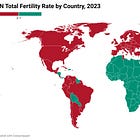Deep Dive: An Impending Population Crisis? World Fertility Rate Hits 60-Year Low
Continued low fertility rates will cause a gradual implosion of the world’s economy as the population ages and dies. At a certain point it becomes difficult, if not impossible, to reverse course.
by Silvia Xu and Rod D. Martin
September 22, 2025
Fertility rates have plummeted worldwide over the past six decades, leading experts to warn of dire consequences as the downward trend continues.
Continued low fertility rates will cause “a gradual implosion of the world’s economy as the population ages and dies,” Steven Mosher, president of the Population Research Institute, said. Mosher is an expert on population control, demography, and China.
“This will not occur overnight, of course, but once it is well underway it will be difficult, if not impossible, to reverse course,” he said.
Fertility rates (the average number of children born to a woman in her lifetime) are different from birthrates (the number of live births per 1,000 people in a population over a given period), although the terms are related and often used interchangeably.
Countries with low fertility rates, of course, also have low birth rates.
Macroeconomist Jesús Fernández-Villaverde called low fertility rates “the true economic challenge of our time,” in a February report for the American Enterprise Institute.
In 1960, the average woman bore four or five children in her lifetime. By 2023, that number had halved to 2.2, approaching 2.1, the replacement level — or the level at which a population replaces itself from one generation to the next.
Yet it’s only that high due to a relatively small part of the world. And not only is it far worse in most of the world, it’s spiraling downward.
In this Deep Dive, we explore that spiral…and its consequences.






